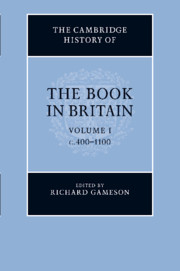Book contents
- Frontmatter
- 1 From Vindolanda to Domesday: the book in Britain from the Romans to the Normans
- PART I THE MAKING OF BOOKS
- PART II THE CIRCULATION OF BOOKS
- 12 Exchanges between the British Isles and the Continent, c. 450 – c. 900
- 13 The circulation of books between England and the Celtic realms
- 14 The circulation of books between England and the Continent, c. 871 – c. 1100
- PART III TYPES OF BOOKS AND THEIR USES
- PART IV COLLECTIONS OF BOOKS
- PART V CODA
- Bibliography
- Concordance of named manuscripts
- Index of manuscripts
- General Index
- Plate 4.1: The Lindisfarne Gospels"
- Plate 5.1: The Lichfield/St Chad Gospels"
13 - The circulation of books between England and the Celtic realms
from PART II - THE CIRCULATION OF BOOKS
Published online by Cambridge University Press: 28 March 2012
- Frontmatter
- 1 From Vindolanda to Domesday: the book in Britain from the Romans to the Normans
- PART I THE MAKING OF BOOKS
- PART II THE CIRCULATION OF BOOKS
- 12 Exchanges between the British Isles and the Continent, c. 450 – c. 900
- 13 The circulation of books between England and the Celtic realms
- 14 The circulation of books between England and the Continent, c. 871 – c. 1100
- PART III TYPES OF BOOKS AND THEIR USES
- PART IV COLLECTIONS OF BOOKS
- PART V CODA
- Bibliography
- Concordance of named manuscripts
- Index of manuscripts
- General Index
- Plate 4.1: The Lindisfarne Gospels"
- Plate 5.1: The Lichfield/St Chad Gospels"
Summary
The Lichfield Gospels, one of the most magnificent surviving manuscripts from the British Isles, has lain quietly in the library at Lichfield Cathedral for hundreds of years (Plate 5.1). At the beginning of the ninth century, however, it was in Wales: a contemporary memorandum records that it was acquired, for the price of an ‘excellent horse’, by a man called Gelhi, and presented by him to the altar of St Teilo (that is, Llandeilo Fawr in Glamorganshire). We do not know from whom Gelhi acquired the book: indeed, its previous owners may have been raiders, who had plundered it from a religious house (in Wales, or further afield?). The Gospels remained at Llandeilo for some time – long enough to receive numerous additions (some lengthy, some merely memorialisations of the deceased), but by the second half of the tenth century it had come to Lichfield. It is not known how or why.
The career of this manuscript may be used to illustrate some of the certainties, and also the insuperable ambiguities, surrounding the circulation of books between England and its Celtic neighbours – Ireland, Wales, Cornwall, Scotland and Brittany. It is known that books did travel from the Celtic realms to England, but the circumstances behind their journeys are often obscure. Equally, it seems self-evident that books must have travelled in the reverse direction (that the Lichfield Gospels began its life in England, rather than Wales, is assumed by many medievalists) – but confirmation is hard to find.
Keywords
- Type
- Chapter
- Information
- The Cambridge History of the Book in Britain , pp. 338 - 343Publisher: Cambridge University PressPrint publication year: 2011
- 1
- Cited by



